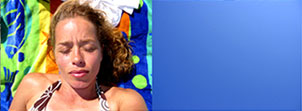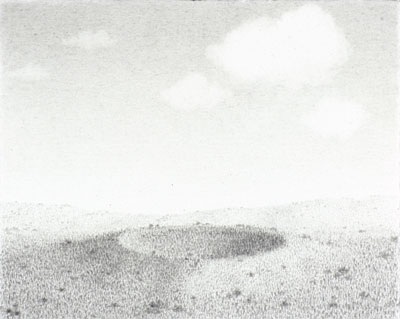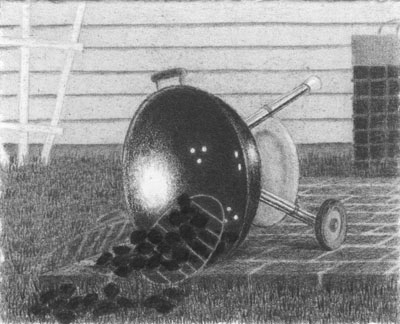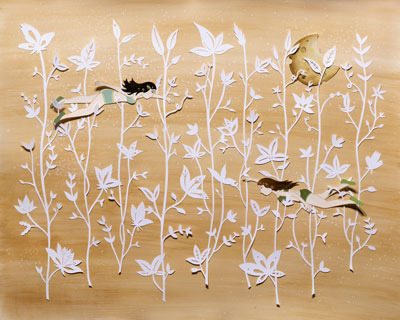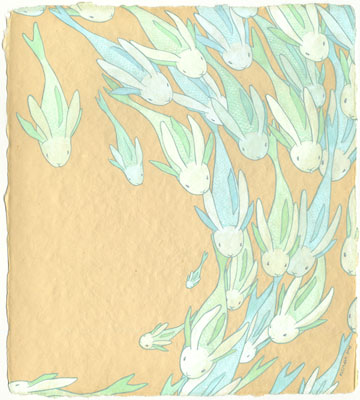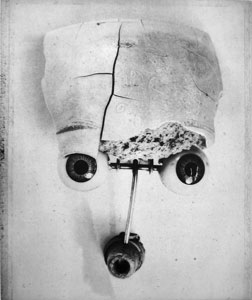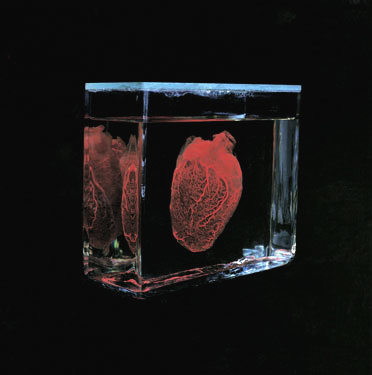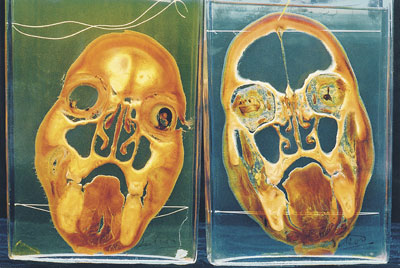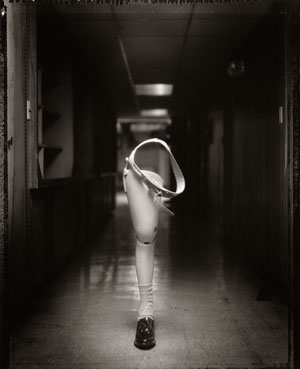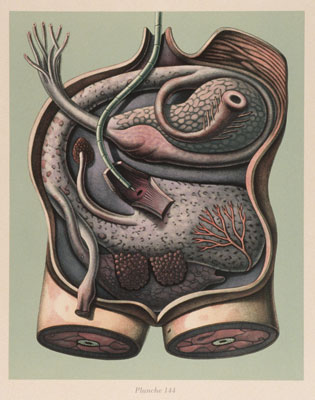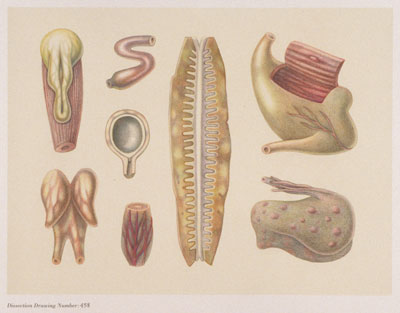








Exhibitions - Fall 2006
|
|
|
|
|
|
October 5 - November 1 |
|
November 9 - December 16 |
|
|
|
| :18
Project Photographs and Video by Christine Gatti
From late July 2004 through mid-January 2006, I took two photographs—one of my face and the other of my surrounding environment—on the 18th minute of each hour of every day. At bedtime, I set the camera on a tripod and programmed the timer to activate as I slept. I chose the 18th minute because I was born on the 18th day of November, and ever since I was a young girl, I’ve noticed the numbers “11:18” on the digital clock next to my bed. Each time, it seems a strange, familiar coincidence. It would be easy for anyone looking at this project to assume that it is about contemporary culture’s fascination with reality TV, fast-paced MTV-style editing, short attention spans and a snapshot aesthetic. However, the motivation behind the project was actually more personal and practical. I wanted to be present in my own life, to come out of my head for a moment or two every hour and take note of where I was in the physical world, to become aware of my feet on the ground. I saw the project as a meditation; a ritual; a commitment added to a less committed life; an experiment. This photographic project is also about the unrelenting presence of the camera. At times, the images allude to the nature of photography, but mostly they are a strict and plain account of the hours. Over the course of 18 months, I found I became less self-conscious, as the vast number of images overshadowed the minute details of my face. Lines became less interesting. Every moment represented in the photographs, important or mundane, has the same weight, and emotion is flat. There is no judgment. This quality emerges markedly in video format. The person in the photographs is me, but my image is a translucent impression fused with half-eaten edamame, highway signs or a computer screen. Over time, I realize this body of work has become less a self-portrait and more a document of anyone’s life. This process, to become mindful for a few moments on the hour, has produced more than 20,000 images. -CG
Photographer and musician Christine Gatti lives and works in New York City. Her passion for photography began when she discovered the macro lens on her father’s Pentax Spotmatic, a fixture in his dental office. Throughout her New Jersey childhood, she experimented with the family’s Super 8 camera and her prized Kodak 110 Pocket Instamatic. Christine received her formal education in photography at the Rochester Institute of Technology and later studied with Andreas Müller-Pohle and Thomas Lüttge in Salzburg, Austria. Since moving to New York, Christine has pursued an eclectic freelancer’s life, assisting fashion photographer Patrick Demarchelier, scouting locations for reality TV shows, wrangling babies for advertising shoots, building sets, composing music for independent films and singing in bars. All of these experiences have informed her work. In 2005, Christine submitted the :18 Project to CEPA Gallery’s annual Members’ Show competition in Buffalo, New York. Juror Louis Grachos, director of the Albright-Knox Art Gallery, subsequently selected the project for a solo exhibition at CEPA’s Flux Gallery. Components of the :18 Project have been shown in the Slideluck Potshow and Group-Show.com, both in New York. Aperture Foundation’s executive book editor Lesley Martin also included Christine’s work in Eleven New Viewpoints as part of “Fellowship 2005” at the Silver Eye Center for Photography in Pittsburgh, Pa. Special thanks to Lawrence Brose at CEPA Gallery, Buffalo, N.Y. Clear Blue Sky:
My recent drawings are idiosyncratic, intimately scaled images derived from personal memories, boyhood fantasies, and the visual environment of my home in the upper Midwest. Carefully drawn in graphite or silverpoint, they are modest in scale, often not much larger than a credit card. Despite their size, they are vivid and dense with information, giving the impression of vast worlds compressed into a tiny field of vision. With their richly rendered, shimmering surfaces, they bring to mind the drawings of Vija Celmins, though they contain an element of humor more reminiscent of a Gary Larson cartoon. This humor stems from their pathos, as the drawings depict a world where the forces of nature have turned against us, making comic props of our material presence on the planet. Images of floods and fires seem silly and naïve, yet are eerily similar to recent pictures from New Orleans or Sumatra. Other drawings represent visions of failed utopian ventures and slightly ridiculous science fiction fantasies of moon colonies and space travel. Mundane domestic spaces become laced with doom and portentous omens while dangers are concealed in fog and hide under blankets. Cumulatively, these drawings express a sense of unease and become metaphors for uncertainty, neglect, disappointment and the failures of contemporary life. -SE
An artist based in Madison, Wisconsin, Scott Espeseth teaches drawing and printmaking as assistant professor of art at Beloit College in Beloit, Wisconsin. He is represented by Dean Jensen Gallery in Milwaukee, and his work has been exhibited in solo and group shows throughout the country, including the Milwaukee Art Museum, the James Watrous Gallery of the Wisconsin Academy of Sciences, Arts and Letters in Madison, and the Stray Show of Chicago. Scott previously taught studio art at Lawrence University in Appleton, Wisconsin, and at the University of Wisconsin-Madison. He earned an MFA in printmaking from the University of Wisconsin-Madison in 2000 and a BFA from West Virginia University in 1997. The exhibition and artist's lecture are supported by the Jeanne Scribner Cashin Endowment Fund for Fine Arts.
Heavenly Friends
Being
asked to create a show… Heavenly Friends features artists from Asia and
the United States. Contributors from Asia include Munkao from
Kuala Lumpur, Eishi
Takaoka from Kagoshima (an isolated region in southern Japan)
and Heisuke Kitazawa or PCP from Tokyo. U.S.-based artists include
Saelee Oh from Los Angeles, Caroline Hwang from New York City,
Deth P. Sun from Oakland, and Jeana Sohn, a Korean now living
in Los Angeles. The exhibition also includes kozyndan, the pairing
of Japanese immigrant Kozue Imamura and southern Californian
Dan Kitchens. Stylistically, their work blurs the lines between creating what is appropriate for contemporary art galleries and taking on more commercial tasks. Media are mixed and matched as well, including narrative illustration, traditional painting, paper cutting and wood sculpture, with the artwork providing the opportunity for an open, accessible dialogue with viewers. In my mind, this is a dream team. -Eric Nakamura, curator
List of Artists
Eric Nakamura and Martin Wong are the publishers of Giant Robot magazine. Eric graduated from UCLA with a degree in East Asian studies and started making magazines through a stint at Larry Flynt Publications. In addition, Eric has made an independent movie called Sunsets, shot photos for punk bands, and designed t-shirts. From movie stars, musicians, and skateboarders to toys, technology, and history, GR magazine covers cool aspects of Asian and Asian-American pop culture. Paving the way for less knowledgeable media outlets, GR put the spotlight on Chow Yun Fat, Jackie Chan, and Jet Li years before they were in mainstream America’s vocabulary. But Giant Robot is much more than idol worship. GR’s spirited reviews of canned coffee drinks, instant ramen packs, Japanese candies, Asian frozen desserts, and marinated bugs have spawned numerous copycat articles in other publications. GR’s historical pieces on the Yellow Power movement, footbinding, Asian-American gangsters, and other savory topics have been cited by academics and journalists alike. Other regular features include travel journals, art and design studies, and sex. -excerpted from www.giantrobot.com The exhibition is presented in conjunction with the New York Conference on Asian Studies, The Asian Subject: Negotiating Identities, October 6-7, 2006, with funding support from the Freeman Foundation's Asian Studies Initiative and the Association for Asian Studies.
Off Kilter: An Installation
Artist’s Statement BARB MADSEN’s art addresses numerous social issues, chief among them the lack of understanding and empathy for people of differing races and beliefs. Through her art, she questions the greed of large companies at the expense of people and the environment, and expresses her desire to combat the hatred and intolerance taught within many cultures. She believes that the angry activist diatribe is no longer an effective strategy. Her work seeks to blur the boundaries among fine art, advertising and pop culture by using provocative imagery, wit and a sense of humor. Over the years, Madsen has collected and photographed a cast of characters that are blithely campy, sinister, creepy and nostalgic, but nonetheless allude to the fact that everything is not quite right in the world. As such, the images seep below the surface of the subconscious to become a transient stratified memory on the cortex. After September 11, 2001, Madsen created two public art projects with the billboards Eye 4 Eye = Blind in Jersey City and Revenge Never Ends in Newark, New Jersey. In the spring of 2005, she produced three banners in the metropolitan Washington, D. C. area: Oh! at the Corcoran Gallery of Art; Fear and Paranoia Win at Studio 1515 on 14th Street; and Who Decides Our Future at Pyramid Atlantic in Silver Springs, Maryland.
BARB MADSEN received her MFA from Drake University in Des Moines, Iowa, and is associate professor of printmaking at Mason Gross School of the Arts, Rutgers, The State University of New Jersey. Her artwork has been exhibited in solo and juried exhibitions in fifteen countries in North America, Europe, Africa and Asia. In 2005, Madsen’s work was presented in Pressing Images/Pressing Issues at the Corcoran Gallery of Art, along with prints by Richard Mock, William Wiley and Enrique Chagoya, and her Eyewitness photogravures were selected by Kiki Smith for the New Prints 2005 exhibition at the International Print Center in New York. The slide lecture and discussion with the artist are supported by the Jeanne Scribner Cashin Endowment Fund for Fine Arts. Extraordinary Bodies:
Photographers and medicine are no strangers. The visual representation of anatomy and pathology as viewed by the camera dates back to the early history of photography when doctors and scientists created anatomical atlases and documented disease and trauma. Photographs also allowed physicians to keep exact visual records of cases long after patients died. The historical bond between photographers and medicine carries forward to the present day with Extraordinary Bodies: Photographs from the Mütter Museum, an exhibition that represents more than a decade of work by contemporary photographers. For some, the medical manipulation of the body—an act that amounts to the isolation of a part from the whole—becomes a visual metaphor for the human condition. Other artists juxtapose real or artificial body parts and the public and private spaces of the museum itself. The exhibition includes images from the museum’s renowned historical photography collection alongside contemporary images that extend the boundaries of traditional photographic subject matter. These works find beauty not in conventional forms, but in internal marvels and the enigma of those whose bodies—deformed, broken and disfigured—have suffered physical abnormality, trauma, or destructive disease. The Mütter Museum, one of the last medical museums from the nineteenth century, comprises a sublime anatomical and pathological collection that originated with Dr. Thomas Dent Mütter, a professor of surgery who collected unique specimens and models for teaching purposes. Under the care of the College of Physicians of Philadelphia, to which Dr. Mütter offered his collection in 1856, the Mütter Museum has grown and survived where others did not. According to Malcolm Jones, the collection “teaches how indelibly strange life can be, how unpredictable and various. The photographs, sometimes ghastly, sometimes heartbreaking, are mysterious and mesmerizing, and [the images] revise and enlarge our idea of what it is to be human.” Artists in the exhibition
Max Aguilera-Hellweg, Prosthetic
Leg in Hallway, Curated by Laura Lindgren, the exhibition is organized by Curatorial Assistance Traveling Exhibitions (CATE), Los Angeles, California.
Hokes Medical Arts:
As proprietor of Hokes Scholarly Lithography from 1901 to 1933, Everett Ormsby Hokes published a wide range of scientific books and manuals. While he is best known for his archaeological [research], particularly his work on ancient near eastern cultures of the Apasht and the Aazud, his contributions to the study of medicine are noteworthy. This exhibition offers a selection of medical and anatomical prints and drawings from over 1,700 color bookplates, as well as a series of preparatory drawings. After studying painting and graphics at the London Academy of
Fine Arts, Hokes worked as an apprentice in two London print
houses in the 1890s. Aside from required courses in figure drawing,
he had no specialized training in medicine or medical illustration,
which occasionally created obstacles to the acceptance of his
work in the academic community. However, the inventive and whimsical
designs, which combined elements of aesthetic beauty and the
grotesque, have made these works popular among amateurs and artists
alike. His prints were collected by Guillaume Apollinaire and
other artists associated with the Surrealist movement such as
Max Ernst and Hans Arp. One of the most unusual bookplates in the exhibition is an unauthorized
English translation of “The Philosophy of Liebniz,” which
features a series of intestinal renderings to accompany one of
Liebniz’s most metaphysical essays. The exhibition also
includes a set of elaborate color pencil “dissection drawings” prepared
for an unpublished anatomical catalogue. Mary Preston Clapp,
who wrote a biography on Hokes, noted that the exact genesis
of this project is unknown. -Beauvais Lyons, Director of
the Hokes Archives
In recent decades, numerous scholars and artists have addressed the subject of the body. Barbara Stafford’s Body Criticism: Imaging the Unseen in Enlightenment Art and Medicine (MIT Press, 1991) offers a history of medical and anatomical science that has evolved since the eighteenth century. More recently, feminism has declared the body a contested territory in relation to the ideals of personal liberty. Given the current political discourse regarding access to health care, and the increasing cultural attention given to beauty and health, the conceptualization and representation of the body suggest multiple levels of meaning. The exhibition, Hokes Medical Arts, is comprised of twenty-five prints and drawings that appear to be authentic depictions of abnormal human anatomy. Instead, they are works of academic parody that employ a documentary tone common to science museums, relating this project to the history of medical quackery. The prints and drawings in the exhibition are also informed by the visual conventions of scientific illustration and nineteenth-century color lithography. Critic Arthur Blade stated that these works “serve as a bridge between the scholarship of Dr. Gray and the whimsy of Dr. Seuss.” In 2001, Beauvais Lyons developed The George and Helen Spelvin Folk Art Collection, an exhibition that examined the creation and connoisseurship of contemporary folk and outsider art. Most recently, he was instrumental in bringing a centaur specimen to the John C. Hodges Library at the University of Tennessee at Knoxville as a permanent display. In 2002, Lyons was a Fulbright lecturer at the Academy of Fine Arts in Poznañ, Poland, and subsequently coordinated the IMPACT 4 International Printmaking Conference there and in Berlin, Germany. More information about the Hokes Archives is available at web.utk.edu/~blyons.
Gallery Hours All exhibitions and related educational programs are free and open to the public. The Gallery welcomes individuals and groups for guided tours; please call (315) 229-5174 for information.
|
| top of page |

